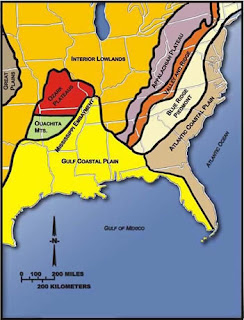 |
| Gulf Shores, Alabama |
 |
| Beautiful white sand in my hand last year at Gulf Shores |
Although human activity has played an important role in the history of the Alabama shoreline, it was created primarily by hundreds of thousands of years of geology. It was during the last 10,000 years, however, that sea levels rose to their present-day elevation. Sea level fluctuations, waves, erosion, and deposition are among the many geologic processes that continue to shape the modern Alabama shoreline. Alabama's Gulf beach sands, which are composed almost entirely of quartz grains, washed out of the ancient Appalachian Mountains hundreds of thousands of years ago. Subsequent sorting by waves and sea level fluctuations have resulted in practically uniform sand grains, accounting for the high quality of the sand on the beaches. Because of their constant exposure to breaking waves, wind, and storms, coastal shoreline environments, including Alabama's, are in a constant state of change and are usually being either eroded or built up. Breaking waves move tons of sand along the Alabama coast through a process known as "littoral drift." The dominant direction of this sand movement is from east to west, but sand moves west to east on occasion, as well.
Erosion is a topic of concern for Alabama’s beaches, also mentioned in this chapter about Hawaii. The location, and look, of almost all of the Alabama shoreline has been affected by human activity. These actions include infilling of wetlands, construction of bulkheads along the bay shorelines to serve as protective barriers to wave erosion, reconstruction of the Gulf beaches, and, primarily, engineering and dredging passes for ship channels. These manmade waterways are a primary cause of Alabama's beach erosion. Since 1960, more than 20 million cubic yards of sand have been removed from the beach, or littoral, system, by the dredging of Mobile Pass for the Mobile Ship Channel. Another 3 million cubic yards of sand have been dredged from the Perdido Pass Channel. The removal of these tremendous volumes of sand has resulted in severe beach erosion in the state during the past several decades because the dredging removes sand that would normally have moved down the coast and been deposited on Alabama's beaches. The solution to Alabama's Gulf beach erosion problem is two-fold. One approach is artificial sand bypassing, a process by which dredged sand is relocated to the beaches where it naturally would have been deposited. The second is a process known as beach nourishment, which involves adding large amounts of good-quality sand to beaches to widen them. This process can be used to rebuild beaches damaged in previous decades. The first major beach nourishment project in Alabama was undertaken by the city of Gulf Shores along two and a half miles of the central business district in 2001, at a cost of approximately $6 million. It was so successful that subsequent projects were implemented to enrich another 14 miles of shoreline extending through the city of Orange Beach. These engineered beaches have been successful in two ways. First, they have saved the Gulf Shores beach that was being squeezed out between the Gulf erosion and the seawalls protecting beachfront condominiums. Second, they have reduced the damage to infrastructure, including roads and condominiums, when hurricanes have hit the coast.
 |
| Erosion in Gulf Shores |
Sources:http://www.encyclopediaofalabama.org/face/Article.jsp?id=h-2049







































